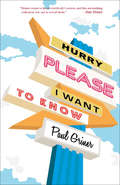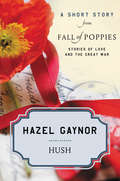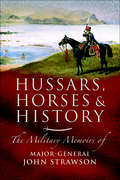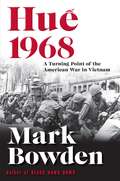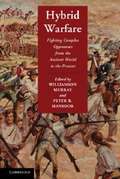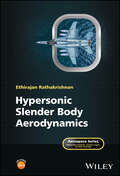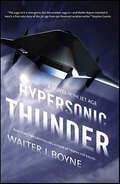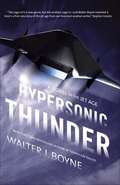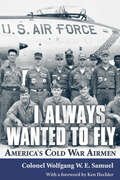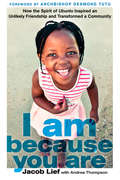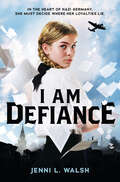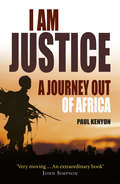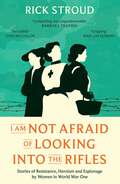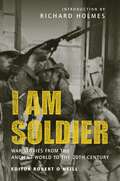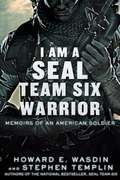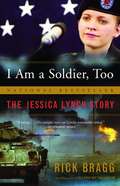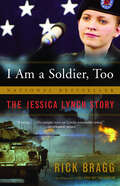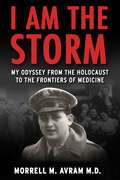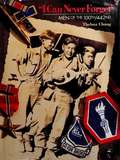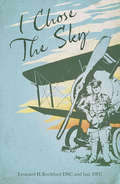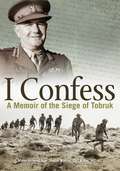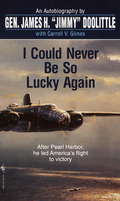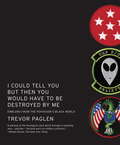- Table View
- List View
Hurry Please I Want to Know
by Paul Griner"Paul Griner's Hurry Please I Want to Know takes the reader on a sweeping tour of America--from Iraqi soldiers to prison telemarketers, from famous cartoonists to bone procurers, from missing persons to the resurrected dead--the real, the surreal, and everything in-between. Griner seems to know everybody's secrets, and this astonishing collection sets out to reveal them."--Dan Chaon, author of Await Your Reply and Stay Awake"Paul Griner finds surprising and inventive ways to write about a wide range of sometimes uncomfortable--but always interesting--situations. The writing is careful, precise, shocking--stylistically brilliant. The stories are sometimes surreal, but convincing all the same. They take your breath away!"--Bobbie Ann Mason, author of The Girl in the Blue Beret and In CountryA stylized and otherworldly short story collection filled with sidelined characters placed at center stage. A low-ranking soldier is forced to milk a cow within enemy range. A cartoonist's daughter waits each morning to see how her father's mood dictates how he will draw her face. Grieving siblings wait to inherit one of their father's physical features after his death.Paul Griner's first book, the story collection Follow Me, was a Barnes and Noble Discover Great New Writers pick. His next two books, the novels Collectors and The German Woman, have been published in half a dozen languages. His work has appeared in Ploughshares, Playboy, One Story, Tin House, Narrative, and Zoetrope, among others. He teaches at the University of Louisville.
Hush: Stories of Love and the Great War
by Hazel GaynorNew York Times bestselling author Hazel Gaynor captivates with a beautifully rendered short story about the strength of a mother's love as the Great War comes to an end at last . . .As the final moments tick down to the eleventh hour of the eleventh day of the eleventh month, signaling the end of fighting, midwife Annie Rawlins is doing everything she can to save an infant's life. Too many have lost too much and Annie prays that the time for sorrow has passed. Meanwhile across the fields of France her son, Will, is on patrol one last time, clinging to thoughts of home and doing all he can to make it there. As the Armistice bells ring out, Annie and Will must fight one last time to grasp the hope of a new life and a new day.Originally published in the moving collection Fall of Poppies: Stories of Love and the Great War, this e-book also includes an excerpt from Gaynor's new novel, The Girl from The Savoy, coming in June 2016.
Hussars, Horses and History: The Military Memoirs of Major-General John Strawson
by John StrawsonJohn Strawson describes joining the 4th Hussars in the Middle East in 1942 and serving with them until amalgamation with the 9th Hussars in 1958 as The Queens Royal Irish Hussars. He commanded the Regiment during the Borneo campaign and was Colonel from 1975 to 1985. His account of war in Italy and of operations in Malaya and Borneo are of special interest.This light-hearted memoir reveals devotion to his family, friends, Regiment and to horses. His adventures with horses and hounds, whipping-in to the legendary Loopy Kennard, and during his time as Master of the Staff College Draghounds are particularly diverting. Addiction to reading and writing led to authorship of twelve military history books.Military appointments included command of a brigade, two years at SHAPE and finally Chief of Staff, UK Land Forces. He then describes working as Westland Aircrafts Military Adviser, mainly in the Middle East and gives a vivid account of life in Cairo in the latter 1970s.In sum General Strawson shows how enjoyable, how varied, sometimes how demanding a soldiers life can be, above all how rewarding, made so by the priceless quality of the regimental system and the comrades with whom he served.
Hué 1968: A Turning Point of The American War in Vietnam
by Mark Bowden<p>With unprecedented access to war archives in the U.S. and Vietnam and interviews with participants from both sides, Bowden narrates each stage of this crucial battle through multiple viewpoints. <p>Played out over 24 days and ultimately costing 10,000 lives, the Battle of Hue was by far the bloodiest of the entire war. When it ended, the American debate was never again about winning, only about how to leave. Hue 1968 is a gripping and moving account of this pivotal moment. <P><b>A New York Times Bestseller</b>
Hybrid Warfare
by Williamson Murray Peter R. MansoorHybrid warfare has been an integral part of the historical landscape since the ancient world, but only recently have analysts - incorrectly - categorised these conflicts as unique. Great powers throughout history have confronted opponents who used a combination of regular and irregular forces to negate the advantage of the great powers' superior conventional military strength. As this study shows, hybrid wars are labour-intensive and long-term affairs; they are difficult struggles that defy the domestic logic of opinion polls and election cycles. Hybrid wars are also the most likely conflicts of the twenty-first century, as competitors use hybrid forces to wear down America's military capabilities in extended campaigns of exhaustion. Nine historical examples of hybrid warfare, from ancient Rome to the modern world, provide readers with context by clarifying the various aspects of conflicts and examining how great powers have dealt with them in the past.
Hypersonic Missile Nonproliferation: Hindering the Spread of a New Class of Weapons
by Richard M. Moore Richard H. Speier George Nacouzi Carrie LeeThis report examines the implications of the proliferation of hypersonic missiles and possible measures to hinder it. This report first explores some of the potential strategic implications of the proliferation of hypersonic missile technology beyond the three major powers, the United States, Russia, and China. It then examines the process of such proliferation. And finally, it discusses possible means for hindering such proliferation.
Hypersonic Slender Body Aerodynamics (Aerospace Series)
by Ethirajan RathakrishnanOne-of-a-kind resource on theoretical and application aspects of hypersonic slender body aerodynamics with many didactic features included throughout Developed using class-tested course material, Hypersonic Slender Body Aerodynamics presents the theoretical and application aspects of the subject in a precise, concise, and student-friendly manner. The text includes a large number of worked examples, figures, diagrams, tables, and exercise problems. This book covers the subject material beginning from the definition of the slender body geometry through to the study of flow field around the body and the calculation of the aerodynamic and thermal loads acting on the body at speeds ranging from low to high (i.e., from incompressible to hypersonic speeds). The Mach number independence principle and approximate theories for caret wings are also covered, among many other key topics. This book is unique in its comprehensive coverage of the topic, enabling readers to find information in one place instead of scattered throughout proprietary wind tunnel test data, flight test data, government technical reports, scientific literature sources, and numerical methods. Some of the concepts explored in Hypersonic Slender Body Aerodynamics include: Wings of supersonic aircraft, covering sharp leading edges and ground and viscous effects, and pressure distribution on surfaces, covering transverse and longitudinal flow Hypersonic aerodynamics, covering atmospheric properties, hypersonic-flow characteristics, governing equations, and flow past a semi-wedge Application of slender-body theory, covering leading-edge heat transfer, sublimation, aerodynamic effects, nose bluntness, blast-wave theory, and thin shock layers Axisymmetric slender bodies, covering potential flow solutions and pressure distribution, and drag of slender bodies, covering shape factor and blunt after-body corrections Skillfully written with a clear and engaging writing style, Hypersonic Slender Body Aerodynamics is an essential learning resource on the subject for undergraduate and graduate students of aerospace engineering and practicing engineers working in aerospace research labs and industries. It is a perfect textbook for courses on slender body aerodynamics.
Hypersonic Thunder (Novels of the Jet Age)
by Walter J. BoyneThe jet age began in 1939 with the brief hop of a secret German airplane. Seventy years later, the entire world depends upon the jet engine in every sphere - political, military, economic, and social. In Hypersonic Thunder, Walter Boyne weaves an intricate story of how the jet engine changed aeronautics and astronautics, pushing the frontiers of flight forward and permitting humankind to enter the space age. Drawing on his knowledge of the period, Boyne paints a gripping picture of jet aviation from the brilliant supersonic Concorde to the coming challenges of hypersonic flight. Using the fictional Shannons as a vehicle, the author ranges the world of aviation, combining the triumphs and tragedies of great aviation companies with the familiar conflicts of family life. All of the great names of aeronautics and astronautics appear here as they did on the historic scene, including such luminaries as Howard Hughes, Kelly Johnson, Burt Rutan, and Steve Fossett. The book thunders with the clash of combat, ranging from the courageous fights of the Israeli Air Force down through the raid on Libya, Operations Desert Storm and Iraqi Freedom, and, most important the ongoing war on terror. And space is not neglected, as Boyne covers everything from Skylab and the Space Shuttle, with its great achievements and terrible tragedies, to the International Space Station. At the Publisher's request, this title is being sold without Digital Rights Management Software (DRM) applied.
Hypersonic Thunder: A Novel of the Jet Age (Jet Age Trilogy #3)
by Walter J. BoyneThe jet age began in 1939 with the brief hop of a secret German airplane. Seventy years later, the entire world depends upon the jet engine in every sphere - political, military, economic, and social. In Hypersonic Thunder, Walter Boyne weaves an intricate story of how the jet engine changed aeronautics and astronautics, pushing the frontiers of flight forward and permitting humankind to enter the space age. Drawing on his knowledge of the period, Boyne paints a gripping picture of jet aviation from the brilliant supersonic Concorde to the coming challenges of hypersonic flight. Using the fictional Shannons as a vehicle, the author ranges the world of aviation, combining the triumphs and tragedies of great aviation companies with the familiar conflicts of family life. All of the great names of aeronautics and astronautics appear here as they did on the historic scene, including such luminaries as Howard Hughes, Kelly Johnson, Burt Rutan, and Steve Fossett. The book thunders with the clash of combat, ranging from the courageous fights of the Israeli Air Force down through the raid on Libya, Operations Desert Storm and Iraqi Freedom, and, most important the ongoing war on terror. And space is not neglected, as Boyne covers everything from Skylab and the Space Shuttle, with its great achievements and terrible tragedies, to the International Space Station.
I Always Wanted to Fly: America’s Cold War Airmen
by Colonel Wolfgang W. SamuelUntil now, no book has covered all of Cold War air combat in the words of the men who waged it. In I Always Wanted to Fly, retired United States Air Force Colonel Wolfgang W. E. Samuel has gathered first-person memories from heroes of the cockpits and airstrips. Battling in dogfights when jets were novelties, saving lives in grueling airlifts, or flying dangerous reconnaissance missions deep into Soviet and Chinese airspace, these flyers waged America's longest and most secretively conducted air war. Many of the pilots Samuel interviewed invoke the same sentiment when asked why they risked their lives in the air—“I always wanted to fly.” While young, they were inspired by barnstormers, by World War I fighter legends, by the legendary Charles Lindbergh, and often just by seeing airplanes flying overhead. With the advent of World War II, many of these dreamers found themselves in cockpits soon after high school. Of those who survived World War II, many chose to continue following their dream, flying the Berlin Airlift, stopping the North Korean army during the “forgotten war” in Korea, and fighting in the Vietnam War. Told in personal narratives and reminiscences, I Always Wanted to Fly renders views from pilots' seats and flight decks during every air combat flashpoint from 1945–1968. Drawn from long exposure to the immense stress of warfare, the stories these warriors share are both heroic and historic. The author, a veteran of many secret reconnaissance missions, evokes individuals and scenes with authority and grace. He provides clear, concise historical context for each airman's memories. In I Always Wanted to Fly he has produced both a thrilling and inspirational acknowledgment of personal heroism and a valuable addition to our documentation of the Cold War.
I Am Alive! A United States Marine's Story of Survival in a World War II Japanese POW Camp
by Charles Jackson Bruce H. NortonIn the bleak and bitter cold of a copper mine in northern Japan, a Chief Petty Officer of the U. S. Navy was given an opportunity to write a prisoner-of-war card for his wife. He was allowed ten words--he used three: "I AM ALIVE!" This message, classic in its poignancy of suffering and despair captures only too well what it meant to be a prisoner of the Japanese Army. Now, acclaimed military historian Major Bruce Norton USMC (Ret.) brings to light a long-forgotten memoir by a marine captured at Corregidor in the spring of 1942 and interned for three devastating years by the Japanese. With unflinching prose, the words of Marine Sergeant Major Charles Jackson describe the fierce yet impossible battle for Corregidor, the surrender of thousands of his comrades, the long forced marches, and the lethal reality of the P.O.W. camps. Joining some of the most important eyewitness accounts of war, I AM ALIVE! is a testament to the men who fought and died for their country. Jackson's unembellished account of what his fellow soldiers endured in the face of inhumanity pays tribute to the men who served America during the war--and shows why we would ultimately prevail.
I Am Because You Are: How the Spirit of Ubuntu Inspired an Unlikely Friendship and Transformed a Commu nity
by Andrea Thompson Jacob LiefIn 1998, Jacob Lief, a 21-year-old American university student, met school teacher Malizole "Banks" Gwaxula in a township tavern in Port Elizabeth, South Africa. After bonding over beers and a shared passion for education, Gwaxula invited Lief to live with him in the township. Inspired by their fortuitous meeting—which brought together two men separated by race, nationality, and age-and by the spirit of ubuntu, roughly translated as "I am because you are"—the two men embarked on an unexpectedly profound journey. Their vision? To provide vulnerable children in the townships with what every child deserves-everything. Today, their organization, Ubuntu Education Fund, is upending conventional wisdom about how to break the cycle of poverty. Shunning traditional development models, Ubuntu has redefined the concept of scale, focusing on how deeply it can impact each child's life rather than how many it can reach. Ubuntu provides everything a child needs and deserves, from prenatal care for pregnant mothers to support through university-essentially, from cradle to career. Their child-centered approach reminds us that one's birthplace should not determine one's future. I Am Because You Are sets forth an unflinching portrayal of the unique rewards and challenges of the nonprofit world while offering a bold vision for a new model of development.
I Am Defiance: A Novel Of Wwii
by Jenni L. WalshBrigitte tries not to ask questions. They don't seem very welcome at her League of German Girls meetings, where she and her friends learn about their duties to Hitler's war effort.But she can't help asking questions when a mysterious pamphlet appears in her mailbox: a pamphlet full of words like resistance and freedom, from a group that calls itself the White Rose. Brigitte's father and older sister, Angelika, seem to agree with the forbidden papers -- an opinion that is dangerous even to whisper at home. And when Angelika becomes involved with secret resistance efforts, Brigitte's questions only bloom.Could Angelika be connected to the White Rose? Is Brigitte's family in danger of being arrested? And if she chooses a side, will Brigitte be able to take a stand?
I Am Justice: A Journey Out of Africa
by Paul KenyonEighty miles off the Libyan coast water is leaking rapidly into the bottom of a dilapidated wooden boat. Twenty-seven men, crammed in side-by-side, desperately attempt to bail it out, but the boat is sinking. In the distance one of their number spots a ship and, forcing the last moments of life from the engine, they move towards it. But the crew refuses to allow them on board. Instead the men scramble onto the floats of a huge industrial tuna net, and watch as their boat rolls over and disappears into the heaving Mediterranean.Like tens of thousands of others Justice set off from his rural village with an idealised vision of an new life in England - the 'home' country - desperate just to earn his way and help his orphaned brother and sister left behind. During his long journey to the African coast, he's captured, jailed and tortured, before escaping and heading northwards again. Once in Tripoli he's duped into handing over his life savings for a trip in a wreck of a boat across miles of open sea to almost certain death. But there is also compassion here and he meets old and wise souls along the way. The tuna net is not the end of Justice's story. It is an extraordinary tale of courage, and an important account of a life caught between cultures, on the edge of survival.
I Am Not Afraid of Looking into the Rifles: Women of the Resistance in World War One
by Rick Stroud&‘A thrilling narrative that creates an extraordinary picture of female resistance&’ The Lady&‘Fascinating&’ Kavita Puri, BBC History Magazine&‘A fierce, intense picture of this aspect of the war . . . it will stay with me&’ Elizabeth Buchan, author of Two Women in Rome On the evening of 31 March 1916, a 23-year-old woman was led from her prison cell in occupied Brussels. She wore a long blue coat and walked &‘like a soldier&’. The chaplain asked if she would like a blindfold before her execution. &‘I am not afraid of looking into the rifles,&’ she replied. &‘I have been expecting this for a long time.&’ This is not a traditional history of the First World War. It is the untold story of the women of the resistance in Belgium and occupied France during that conflict. Rick Stroud describes how the actions of eight exceptionally brave women affected the course of the war. Before the Germans invaded, they were ordinary people: some, like Gabrielle Petit, were working-class; some, like Edith Cavell, were from the bourgeoisie; and some. like the Princess de Croÿ, were from the upper echelons of society. The youngest was only twenty-one. The women took enormous risks and produced extraordinary results: they established underground networks, transmitted coded information, carried out sabotage attacks and helped to repatriate Allied soldiers. What they did was dangerous and exhausting and the penalties were severe: three faced the firing squad. Recounting their heroism and their inevitable tragedies, I Am Not Afraid of Looking into the Rifles is an enthralling story, beautifully told. In revealing the inspiring work of these remarkable women, Rick Stroud will introduce you to an entirely new version of the &‘war to end all wars&’.
I Am Soldier: War Stories, from the Ancient World to the 20th Century
by Robert O'NeillI Am Soldier brings together the profiles of sixty soldiers who have fought over the past 2,500 years. These vivid accounts graphically depict the role of the soldier in battle often using the soldiers' own words to reveal what they felt during the chaos of war and its aftermath. From the Spartans at Thermopylae to the war in the Persian Gulf, this book shows the lives of the individual men and woman who made up the great armies that changed the world.
I Am a Seal Team Six Warrior: Memoirs of an American Soldier
by Howard E. Wasdin Stephen TemplinI Am a SEAL Team Six Warrior is the dramatic tale of how Howard Wasdin overcame a tough childhood to live his dream and enter the exciting and dangerous world of U.S. Navy SEALS and Special Forces snipers.
I Am a Soldier, Too: The Jessica Lynch Story
by Rick BraggIn I Am a Soldier, Too, Bragg let’s Jessica Lynch tell the story of her capture in the Iraq War in her own words--not the sensationalized ones of the media's initial reports. Here we see how a humble rural upbringing leads to a stint in the military, one of the most exciting job options for a young person in Palestine, West Virginia. We see the real story behind the ambush in the Iraqi Desert that led to Lynch's capture. And we gain new perspective on her rescue from an Iraqi hospital where she had been receiving care. Here Lynch’s true heroism and above all, modesty, is allowed to emerge, as we're shown how she managed her physical recovery from her debilitating wounds and contended with the misinformation--both deliberate and unintended--surrounding her highly publicized rescue. In the end, what we see is a uniquely American story of courage and true heroism.
I Am a Soldier, Too: The Jessica Lynch Story
by Rick BraggPulitzer Prize-winning journalist and bestselling author Rick Bragg lends his remarkable narrative skills to the story of the most famous POW this country has known.In I Am a Soldier, Too, Bragg let's Jessica Lynch tell the story of her capture in the Iraq War in her own words--not the sensationalized ones of the media's initial reports. Here we see how a humble rural upbringing leads to a stint in the military, one of the most exciting job options for a young person in Palestine, West Virginia. We see the real story behind the ambush in the Iraqi Desert that led to Lynch's capture. And we gain new perspective on her rescue from an Iraqi hospital where she had been receiving care. Here Lynch's true heroism and above all, modesty, is allowed to emerge, as we're shown how she managed her physical recovery from her debilitating wounds and contended with the misinformation--both deliberate and unintended--surrounding her highly publicized rescue. In the end, what we see is a uniquely American story of courage and true heroism. From the Trade Paperback edition.
I Am the Storm: My Odyssey from the Holocaust to the Frontiers of Medicine
by Morrell Michael AvramMorrell Avram, born in Bucharest, could have easily become one of the 200,000 Romanian Jews killed by the German Nazis or their Romanian allies. I AM THE STORM is the riveting true story of how he survived—and later triumphed as a pioneering doctor—through a combination of grit and persistence. At age 11, Avram was separated from his mother and baby sister because the US Embassy would only allow them to immigrate on the condition that they leave Morrell and his father behind. What the family hoped would be a brief separation became six terrifying years. Amid the horrors of the war, Morrell had to fend mostly for himself, shuttling from relative to relative, hiding place to hiding place. Among his close calls: He longed to buy a ticket on the Struma, a ship taking Jewish refugees from Romania to Palestine, that was torpedoed and sank along with many of his friends. He walked into his bar mitzvah ceremony with dozens of Nazi soldiers stationed outside the synagogue. He was strafed and nearly killed by an American warplane. Upon finally escaping Romania and reuniting with his mother and sister, Avram faced a host of new challenges in New York. After getting through high school with minimal English, he was thrilled to get into college but found it impossible to juggle classes while working to help support his family. By age 21, it looked as if his dream of becoming a doctor was doomed. But relief came from an unlikely source—a draft notice from the US Army, which transformed him from an anxious &“subway rat&” into a focused soldier, driven by the words of his drill sergeant: &“You are the storm! You are invincible!&” Avram&’s unlikely journey continued as a med student in Brussels and Geneva, as a young doctor in Brooklyn, and as one of the leaders of the new field of nephrology. He became a pathbreaking specialist in dialysis and kidney transplants, saving tens of thousands of patients personally and millions more through treatments he helped devise.
I Can Never Forget: Men of the 100th/442nd
by Thelma Chang Franklin Odo Daniel InouyeHere are the voices and stunning images of extraordinary men, Japanese American soldiers of World War II who belonged to the most decorated units of their size in U.S. Army history: the 100th Infantry Battalion and 442nd Regimental Combat Team. Together, the men of the 100th/442nd were an unstoppable force as they blazed through Europe with their "Go For Broke" spirit. Feared by German troops, revered by villagers, the Japanese Americans were at once fierce fighters, gentle liberators and prisoners of war in more ways than one. Now, decades after the war, the usually reserved and silent warriors reveal their innermost thoughts and feelings about this tumultuous time in their lives. We hear from men who volunteered from Hawaii plantations and American-style concentration camps. We discover how the men rose above the binds of war and racism and responded to injustice with an untarnished record of valor.
I Chose the Sky
by Leonard H. RochfordA fascinating, insightful, and nail-biting account by a World War One veteran—a Grub Street Classic previously out of print for more than thirty years. In these exciting memoirs, &“Tich&” Rochford writes about his two action-filled years as a World War I fighter pilot with the famous No. 3 (Naval) Squadron when he flew planes such as the Sopwith Pup and the Sopwith Camel. While flying many hundreds of hours in operations he was credited with many single-handed victories or driven out of control, and he vividly recalls these engagements in the air and the exploits of the pilots with whom he flew, names that include other fighter aces like Raymond Collishaw, who has written a foreword to this book, T. F. Havell, R. H. Mulock and L. S. Breadner. A member of his flight, Lt. Col. Kirkpatrick said of him, &“I always had the impression that what he did came naturally to him. If he saw an enemy aircraft and decided to attack, that was that. He went screaming down on it and we all had our work cut out to keep up with him. One could be pretty sure of the victim going down in flames.&”&“This excellent autobiography is highly recommended.&” —Over the Front
I Confess: A Memoir of the Siege of Tobruk
by Major General Joseph J. MurrayI Confess is an intimate portrayal of command in the crucible of war. Major General John Joseph Murray fought in the AIF in both the First and Second World Wars. He won the Military Cross as a company commander during the disastrous Battle of Fromelles, and in the Second World War he commanded the Australian 20th Brigade during the siege of Tobruk, that grinding, tortuous desert defence that saw the German forces label his men 'rats', a badge they have worn since with pride and honour. I Confess is a carefully crafted analysis of leadership under pressure, a very personal reflection on its stresses, its tragedies and its lifelong rewards.
I Could Never Be So Lucky Again: An Autobiography
by Carroll V. Glines James DoolittleAfter Pearl Harbor, he led America's flight to victoryGeneral Doolittle is a giant of the twentieth century. He did it all. As a stunt pilot, he thrilled the world with his aerial acrobatics. As a scientist, he pioneered the development of modern aviation technology. During World War II, he served his country as a fearless and innovative air warrior, organizing and leading the devastating raid against Japan immortalized in the film Thirty Seconds Over Tokyo. Now, for the first time, here is his life story -- modest, revealing, and candid as only Doolittle himself can tell it.From the Paperback edition.
I Could Tell You But Then You Would Have to Be Destroyed By Me: Emblems from the Pentagon's Black World
by Trevor PaglenUpdated with New Information and Additional Patches. They're on the shoulders of all military personnel: patches showing what a soldier's unit does. But what if that's top secret? "A glimpse of [the Pentagon's] dark world through a revealing lens-patches--the kind worn on military uniforms... The book offers not only clues into the nature of the secret programs, but also a glimpse of zealous male bonding among the presumed elite of the military-industrial complex. The patches often feel like fraternity pranks gone ballistic." -William Broad, The New York Times. I COULD TELL YOU is a bestselling collection of more than seventy military patches representing secret government projects. Here author/photographer/investigator Trevor Paglen explores classified weapons projects and intelligence operations by scrutinizing their own imagery and jargon, disclosing new facts about important military units, which are here known by peculiar names ("Goat Suckers," "Grim Reapers," "Tastes Like Chicken") and illustrated with occult symbols and ridiculous cartoons. The precisely photographed patches--worn by military personnel working on classified missions, such as those at the legendary Area 51--reveal much about a strange and eerie world about which little was previously known. "A fresh approach to secret government." -Steven Aftergood, The Federation of American Scientists. "An impressive collection." -Justin Rood, ABC News. "A fascinating set of shoulder patches." -Stephen Colbert, The Colbert Report. "I was fascinated... [Paglen] has assembled about 40 colorful patch insignia from secret, military 'black' programs that are hardly ever discussed in public. He has plenty of regalia from the real denizens of Area 51." -Alex Beam, The Boston Globe.
